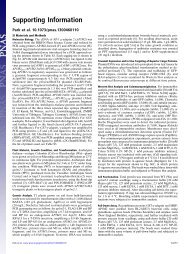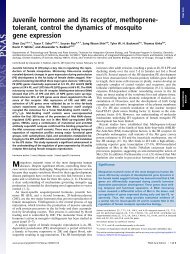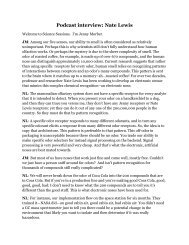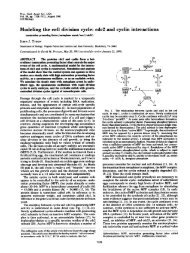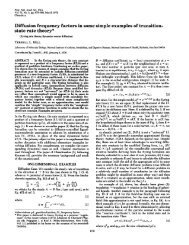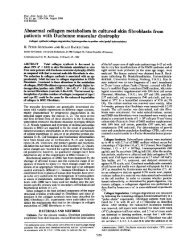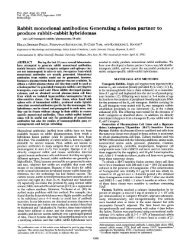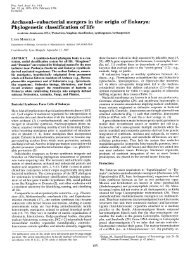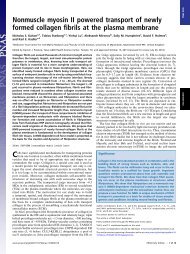Supporting Information (SI) Appendix - Proceedings of the National ...
Supporting Information (SI) Appendix - Proceedings of the National ...
Supporting Information (SI) Appendix - Proceedings of the National ...
You also want an ePaper? Increase the reach of your titles
YUMPU automatically turns print PDFs into web optimized ePapers that Google loves.
<strong>the</strong> eastern sylvestris is more questionable than <strong>the</strong> identity <strong>of</strong> <strong>the</strong> western sylvestris because<br />
eastern sylvestris clusters more closely with vinifera in genetic space (Figures S7) and because it<br />
is safe to assume that <strong>the</strong>re was a much longer period <strong>of</strong> potential contact between sylvestris and<br />
vinifera in <strong>the</strong> east than in <strong>the</strong> west. We <strong>the</strong>refore performed <strong>the</strong> LD decay and haplotype<br />
diversity analyses with only <strong>the</strong> western sylvestris samples instead <strong>of</strong> <strong>the</strong> full sylvestris sample.<br />
Our results remain unchanged and this demonstrates that our conclusions are robust to this<br />
potential source <strong>of</strong> misidentification. Moreover, it is clear that levels <strong>of</strong> haplotype diversity are<br />
very high in vinifera regardless <strong>of</strong> <strong>the</strong> diversity observed in our sample <strong>of</strong> sylvestris (median<br />
haplotype diversity <strong>of</strong> 5 SNP haplotypes = 0.80, Figure 3), which is consistent with a weak<br />
domestication bottleneck. Finally, it is worth noting that our model <strong>of</strong> a weak domestication<br />
bottleneck is consistent with <strong>the</strong> widespread use <strong>of</strong> vegetative propagation during <strong>the</strong> history <strong>of</strong><br />
grapevine breeding [11] and <strong>the</strong> relatively minor morphological changes between sylvestris and<br />
vinifera [6].<br />
Our analysis using <strong>the</strong> 3-population test [12] supports a scenario in which vinifera from western<br />
Europe are <strong>the</strong> result <strong>of</strong> an admixture event between vinifera from <strong>the</strong> east and sylvestris from<br />
western Europe. Using this same test, we find no support for a scenario in which our “western<br />
sylvestris” sample is influenced by gene flow from vinifera. To our knowledge, this is <strong>the</strong> most<br />
robust statistical framework we can employ to test models <strong>of</strong> <strong>the</strong> admixture history <strong>of</strong> vinifera<br />
and sylvestris. This test, in conjunction with <strong>the</strong> PCA results (Figure 4), provides strong support<br />
for <strong>the</strong> unique, unadmixed identity <strong>of</strong> <strong>the</strong> western sylvestris sample. Because <strong>the</strong> eastern<br />
sylvestris sample is almost indistinguishable from <strong>the</strong> vinifera (Fst < 0.06 to all vinifera<br />
populations, which is <strong>the</strong> pattern we expect if domestication occurred in <strong>the</strong> east and <strong>the</strong>re was a<br />
weak population bottleneck), <strong>the</strong> identity <strong>of</strong> <strong>the</strong> eastern sylvestris will necessarily rely on <strong>the</strong><br />
morphological criteria used for its identification. However, <strong>the</strong> identity <strong>of</strong> <strong>the</strong> eastern sylvestris<br />
is extraneous to our main conclusion that western vinifera experienced introgression from<br />
western sylvestris: <strong>the</strong> 3-population test used to test this hypo<strong>the</strong>sis does not include eastern<br />
sylvestris.



